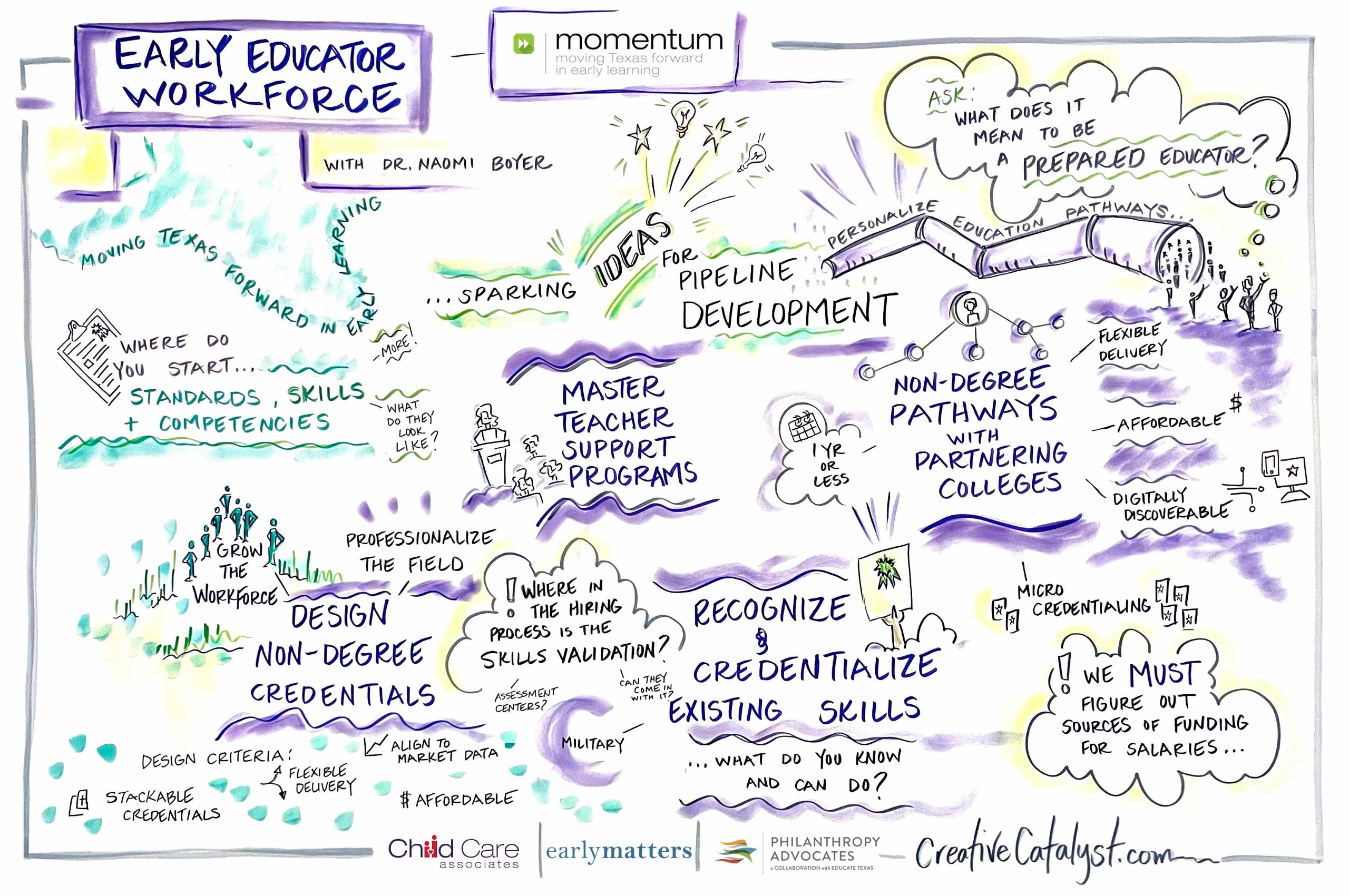Catherine Davis and Jordan Brown | June 18, 2024
Responding to a Moment of Need & a Moment of Opportunity for ECE in Texas
Despite a $32.7 billion surplus in the Texas budget and a well-documented need for a stronger, more accessible early learning system, child care came away with no major wins in Texas 88th Legislative Session in 2023. With room for investment and growing public, bipartisan consensus that the child care system is fundamentally broken, why was there so little progress for working families made by the legislature?
The child care and early learning system in Texas is a complex one—spread across multiple agencies with issues ranging from affordability to quality to increasing parent choices and ensuring a supported workforce. The multifaceted challenges facing the system have inherently resulted in diverse perspectives amongst stakeholders on where and how to begin approaching solutions. Without a cohesive vision and message, legislators were left with little understanding of the best path forward.
As advocates, we have learned our lesson. Moving the system forward will require that we come together and agree upon a clear vision and common goals for a strong early learning system in Texas. This was the purpose of the 2024 Momentum Early Learning Summit.
Mixed Delivery and Workforce Challenges
In a mixed-delivery system, publicly funded pre-k can be equitably accessed in a variety of settings, including public schools, community-based child care programs, and Head Start. The concept of mixed-delivery is reliant on how we incorporate, support, and cultivate the early educator workforce. The field is struggling to recruit and prepare a high-quality workforce with extremely high teacher turnover rates in child care centers.
The Momentum Summit focused on two critical systems issues currently holding Texas’ early childhood system back: 1) the lack of an integrated approach to pre-kindergarten that includes community-based child care providers in the public pre-k system (known as mixed-delivery prekindergarten), and 2) the severe shortages of qualified early childhood educators due to chronically low wages and disparate career pipelines and pathways.
With robust representation from 15 Texas regions as well as state agencies, systems leaders, early learning centers, and advocacy organizations from across Texas, the Momentum Summit was the first of its kind to bring together a vastly diverse set of participants to begin tackling these issues and engage in vision-setting for Texas’ early learning system.
Sparking Innovation, Aligning Interests & Setting a Statewide Vision
During the 24-hour intensive, summit participants heard from a panel featuring Texas Workforce Commission Chairman Bryan Daniel, Commissioner of Education Mike Morath, and Fort Worth Mayor Mattie Parker regarding the current systems-level challenges facing child care in Texas. The panelists provided their own perspectives on Momentum’s key topics, providing several key takeaways that served as a level-set for the event.
Participants spent most of the summit working alongside national policy and systems-experts towards a vision for a strong mixed-delivery system and early educator workforce, examining various models and approaches to each issue.
Texas’ 2030 Vision Statements for a Strong Early Learning System
The summit ultimately culminated in a series of design sessions aimed at developing core vision statements aligned to four key pillars—Enabling Conditions, Access, Quality, and Workforce—for what needs to be true in Texas to resolve these systems issues by 2030.
Enabling Conditions
Texas Vision Statement
In order to sustain a mixed-delivery prekindergarten system in Texas, by 2030, early education funding inputs will incentivize different funding streams (e.g., federal, state, private), and the state will ensure that the true cost of quality is funded so that all families have access to the high-quality provider of their choice. This model will ensure equitable funding distribution across community-based providers and local education agencies (LEAs), with a focus on high-impact outcomes and reduction of duplicative resources and waste.
 Across stakeholders, there was clear consensus that a well-functioning child care system will require an efficient and robust funding approach. In Texas, this means working towards a system in which different funding streams can easily work together (and therefore be maximized), as well as ensuring the system is adequately funded so that families can access the high-quality provider of their choice.
Across stakeholders, there was clear consensus that a well-functioning child care system will require an efficient and robust funding approach. In Texas, this means working towards a system in which different funding streams can easily work together (and therefore be maximized), as well as ensuring the system is adequately funded so that families can access the high-quality provider of their choice.
A key tenet here is ensuring child care programs can equitably access existing state pre-k funding—an important lever for increasing availability of pre-k, maximizing available funding, and stabilizing child care costs. This could include revisiting the current Pre-K Partnership model—in which LEAs only pass through a portion of pre-k funding to partnering child care programs—or creating a new and distinct funding stream specifically for pre-k programs operating in child care centers.
With regards to child care funding, Texas currently relies solely on the federal Child Care and Development Fund (CCDF). CCDF alone is not sufficient to fund the true cost of quality, and the current model (which focuses only on per-child subsidy reimbursements) creates instability within the market. To ensure a more robust and functional system, Texas could consider supplementing the CCDF block grant to provide foundational funding for child care programs. By focusing on supply-side funding, Texas could better target areas with low supplies of child care (e.g., child care deserts, infant/toddler care, non-traditional hour care, etc.) in order to improve access. This could work concurrently with child care subsidies for eligible families, as well as pre-k funding for eligible students—both of which provide per-child, demand-side supports.
Additional funds could originate from state or local revenue sources, as well as private and/or philanthropic sources that wish to target certain areas or types of care.
Access
Texas Vision Statement
By 2030, the Texas Legislature and the Governor will, in collaboration with state agencies, create a unified early education governance system that eliminates bureaucracy and cost duplication and creates a more coordinated and accessible early childhood education system for all families to access care that meets their unique needs, including through a single intake system and aligned program eligibility for services related to early childhood.
Ensuring sufficient access to early childhood resources requires creating a streamlined governance system that is more intentionally family-centered. This streamlined system must also foster a friendlier business environment for community-based providers by removing unnecessary red tape and duplicative regulation.
Governance of the Texas early childhood education system is spread across three agencies: the Texas Workforce Commission (TWC; funding and quality), the Texas Education Agency (TEA; pre-k), the Health and Human Services Commission (HHSC; child care licensing). This disjointed structure of operations can result in administrative inefficiencies and overlapping regulations, creating unnecessary barriers for community-based providers. In addition, families seeking child care, Head Start/Early Head Start, and/or other social services must traverse the bureaucracy of numerous agencies, resulting in many families missing out on resources for which they qualify. There remains much work to be done in ensuring early childhood education is accessible—both from a customer service and service delivery standpoint.
Texas could resolve these inefficiencies by 1) consolidating early childhood governance under one roof, or 2) creating regional/local intermediaries that coordinate scattered resources. Other states have modeled varying approaches to eliminating these inefficiencies, including through the creation of an early childhood state agency, a department housed within an existing state agency, oversight by a single entity at the Office of the Governor, or a regional hub system.
Quality
Texas Vision Statement
By 2030, all early childhood education environments in Texas will share a common, evidence-based, and developmentally appropriate understanding and practice of high-quality early learning and care.
Our definitions of “high-quality” must be research-based, clearly defined, and standardized across settings, to the extent applicable. In Texas, the definition of high-quality depends on the setting in which a program operates. For example, Pre-K 3 classrooms must only be licensed under HHSC, Pre-K 4 classrooms must meet TEA’s High Quality Pre-K (HQPK) requirements, Head Start programs must meet federal regulations, and child care programs are held to licensing standards. Even further, those who wish to be designated as quality must become certified under Texas Rising Star (TRS) or nationally accredited. Each has varying levels of quality control, such as class size, teacher qualifications, curriculum, family engagement, and even the physical set-up of the classroom.
To date, state-mandated requirements for HQPK and TRS have focused more on inputs into the classroom than on the program’s outcomes. With only 49% of children entering kindergarten ready to learn (TEA, 2023), Texas must look beyond simply mandating inputs—with little evidence of whether they yield positive outcomes for children—in favor of analyzing child outcomes across settings. This analysis should inform a new standardized definition of high-quality early learning and care, including educator certification and degree requirements.
Texas’ HB 2729 (88R) is a prime example of a quality requirement that has been re-envisioned. This policy created alternative requirements for pre-k teachers in community-based settings, recognizing that being a quality early educator is not necessarily dependent on a certain degree or certification. Texas should continue to pursue data-informed analyses of different teacher credential “inputs,” which could potentially lead to a redefinition of “high-quality pre-k teacher” altogether.
Workforce
Texas Vision Statement
By 2030, Texas will utilize pathways designed and governed by their early childhood profession that lead to competency-based, stackable credentials which leverage prior learning and experience and are recognized across program settings and governing institutions.
 Early childhood educators do not have clear, stair-stepped pathways to attaining high-level certifications as they progress in their career. There is currently no widely-recognized transferability of credits from the CDA to a two-year associate degree in early childhood education, and four-year higher education institutions may not count all credits earned from an associate degree towards a bachelor’s degree.
Early childhood educators do not have clear, stair-stepped pathways to attaining high-level certifications as they progress in their career. There is currently no widely-recognized transferability of credits from the CDA to a two-year associate degree in early childhood education, and four-year higher education institutions may not count all credits earned from an associate degree towards a bachelor’s degree.
Additionally, child care educators—who often make near poverty-level wages—are usually limited in their ability to leave the classroom in order to pursue higher education. Given these challenges, there was widespread recognition of the need to provide greater access to on-the-job, competency-based training that would allow early childhood educators alternative pathways to advancing in their career (and ultimately increase their compensation), without having to leave the classroom to pursue a formal degree pathway.
To resolve this, TWC and the Texas Higher Education Coordinating Board could collaborate on standardizing the award of credit process for early childhood education degrees, as well as identify competency-based credentials that can be stacked and held in esteem to formal degrees. Additionally, Texas could work towards statewide recognition of the TECPDS practitioner career pathways, which outline alternative routes for early childhood education career progression by equating stacked micro-credentials, certificates, and CDAs to high-level degrees and certifications.
Conclusion
Despite the many diverse perspectives in the room, Momentum’s participants agreed upon strong vision statements that will serve as statewide guideposts for developing a common early education policy agenda for the next six years. The potential steps noted in this blog post are by no means the full breadth of available solutions. Advocates must continue working together to identify the most viable solutions, and the Momentum Summit’s planning team will continue shepherding the outcomes of the event forward through collaboration with summit participants, key stakeholders, and advocates in the space.

